This was published 4 years ago
'Most of Australia hated him': The judge with the red paddle who broke Australia's heart
Walker Jane Saville experienced the agony of being disqualified just short of an Olympic gold medal at the Sydney Games in 2000. But how did it feel to be the official who showed her the red card?
By Iain Payten
Lamberto's English was not strong at the best of times but he was particularly quiet on this night.
A few of the racewalking judges had gathered after dinner at the Lidcombe apartments where Sydney Olympics athletics officials were camped for the Games.
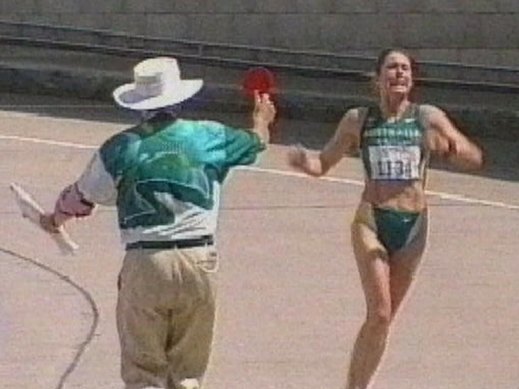
Lamberto Vacchi shows Jane Saville a red card at the Sydney Olympics.Credit: Channel Seven
All were weary. The day had been long, hot and controversial, and an outraged Australian media hadn't even hit full stride.
It was September 28, 2000, and earlier in the day Australian walker Jane Saville had been heartbreakingly disqualified just a few hundred metres from a gold medal in the 20km walk.
The quiet man was Lamberto Vacchi, a genial Italian racewalking judge.
You've seen Vacchi but probably never heard his name.
Vacchi was the Olympic official who, dressed in fawn pants and a white hat, jumped out and showed Saville the red paddle about 200m shy of a gold medal, ripping away her Olympic dream.
"Lamberto was distraught," recalls veteran Australian walking judge Bob Cruise.
"He was just down that night. As a judge, DQing anyone who is in the lead in the Olympics or a major event, it's pretty tough.
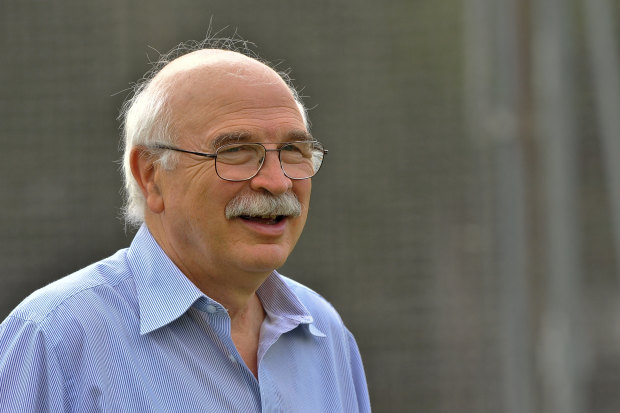
Sydney Olympics walking judge Lamberto Vacchi, at his home in Italy.
"But Jane being an Australian and it being her home crowd and everything … he felt for her.
"There was a newspaper cartoon I came across that night for some reason, showing him with his paddle. I showed him that and thought it might cheer him up.
"It didn't improve his mood. Not one bit."
A brutal sport
Racewalking cops plenty of ribbing but it is unquestionably a brutal sport.
There's the physical toll of walking at a pace a vast majority of us couldn't run – think four-minute kilometres – but the kicker is athletes also risk getting turfed out of the race at any minute, if the competitive instinct revs too high and they push too hard to win.
Racewalking is one of the few Olympic sports where restraint is as important as effort, lest your walk turns into, technically, a run.
And walking judges, well, they don't muck around. They see themselves as the arbiters of fairness and are prepared to disqualify as many people as is required, even on the Olympic stage.
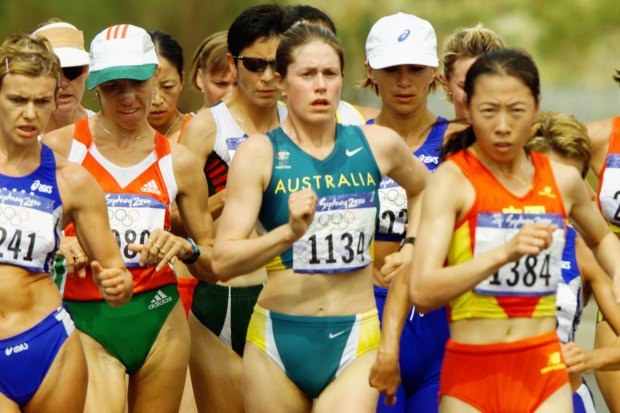
Jane Saville in action at the start of the women's 20km race at the Sydney Olympics.Credit: Dallas Kilponen
"The overall aim of the judge is to ensure a walker wins a walking race," says Cruise.
So, after a 31-year career as a racewalking judge that included world championships and Olympics, Vacchi was no shrinking violet. The 60-year-old's appointment as chief judge of the racewalking races at the Sydney Olympics in 2000 reflected as much.
But the bank manager from Italy also happened to be widely regarded in the sport as a genuine nice guy.
And when contacted by The Sydney Morning Herald and The Age in his home near San Benedetto Val di Sambro, a small town in the Tuscany region, Vacchi couldn't have been happier to share his memories of Sydney for the first time.
"When I got the call [to be chief judge] it was a great joy," Vacchi said. "I was happy with this assignment and determined to do my job well."
Here is the moment for a crash course in the rules and regulations of racewalking. Put simply, a walker must always have one foot on the ground. Slow-mo replays and still photography can find two feet in the air pretty easily but judges can only determine a "loss of contact" by what they can see with the naked eye.
"If you start doing your maths with all of that, the loss of contact is generally somewhere between 30 milliseconds and 70 or 80 milliseconds," Cruise, who is the president of Race Walking Australia, says.
"Even a good judge can't really see up until about 50 milliseconds, so it's just too quick for the naked eye."
Walkers must also keep their "contact" leg straight.
There are eight judges on course for an Olympic race and competitors operate on a three strikes and you're out basis. If an athlete gets three strikes, the chief judge is notified and as quickly as possible – it can take a few minutes – they move to a spot where they whip out the red card and disqualify the walker. Red carding is the chief judge's primary role; they don't do any in-race judging.
It's real-time bureaucracy so a well-oiled machine is required or things can go wrong.
And in the first walking race of the Sydney Olympics – the men's 20km – things definitely went wrong.
If you thought Saville did it tough in Sydney, spare a thought for Mexican walker Bernardo Segura.
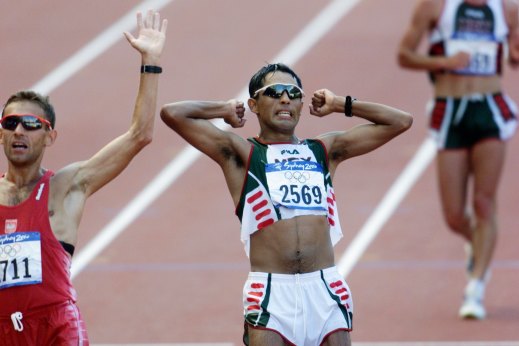
Bernardo Segura crosses the line first in Sydney but he wouldn't be given a gold medal.Credit: Fairfax Photographic.
Segura crossed the line first and Mexico was ecstatic. Segura even took a phone call from the Mexican president trackside.
The problem was Segura's fast finish had been too fast and Cruise had slugged him with a third strike a few hundred metres outside the stadium entrance.
Vacchi was too far away on the course disqualifying another walker to stop Segura before he finished.
Eventually, after Vacchi waited politely for the presidential phone call to finish and 15 minutes after he'd crossed the line, Segura was told he'd been disqualified.
The Mexican president complained to IOC boss Juan Antonio Samaranch and an appeal was lodged with CAS. It was dismissed but it was all too messy for the chief judge.
"In light of the experience of the 20km men, for the women's race I changed my position by moving to the end of the tunnel," Vacchi said.
"About 120 metres from the finish."
'I thought I was going to be just like Cathy'
Jane Saville was an Australian champion and a Commonwealth gold medallist but she wasn't among the favourites to win Olympic gold in the 20km in Sydney. She'd been badly hampered by injury in the months leading up to the Games.
"She would only have been in the top half-dozen. But she did well on the day and there were about four or five of the top women [that] had been disqualified by the time she got to the lead," Cruise recalls.
Deep into the race, Saville was hanging tough with the leaders but Atlanta Olympics silver medallist Elisabetta Perrone, of Italy, looked the winner.
But tension does strange things. Perrone's restraint slipped and on the ninth 2km loop the Italian picked up three strikes. Whack, whack, whack and out.
Saville took the lead but unhelpfully a confused Perrone continued for another lap before stopping.
With China's Wang Liping 30m behind, Saville was now minutes away from living out her dream.
Speaking from her home in Spain, Saville said she could hear the buzzing crowd of 97,000 sitting in the hulking stadium. There were 97,001 people excited about her imminent arrival on the track.
"I thought I am going to be just like Cathy [Freeman], how good is this?" Saville said.
"I remember coming down the ramp and hearing people and thinking 'Wow, this is for me'."
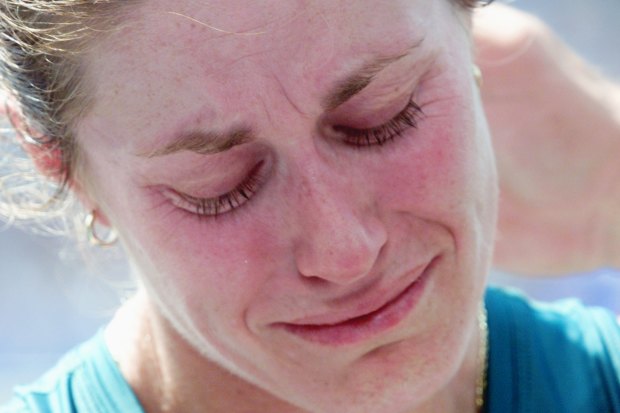
Jane Saville was distraught after being red-carded.Credit: Craig Golding
Vacchi was in his new spot at the foot of the concrete driveway, unintentionally hidden, as Saville charged down.
The humble bank manager felt a knot in his stomach. He'd just been informed Saville had picked up a third strike a kilometre back and was out. This one would be brutal.
"I remember well when I had to show the red paddle," Vacchi said.
"I was aware of the great disappointment that I would have caused to the Australian public who was waiting for her on the podium. It was a regret that shortly before I had caused the Italian public [with Perrone], who were following the race on television."
Two years before Bradbury had even done his first Bradbury, Liping strolled by and claimed the gold medal.
Saville's anguish was raw.
With his back to the camera and faceless, Vacchi took the public form of a heartless, even slightly over-eager, judge. Cruelly officious.
"But Lamberto was basically the executioner, not the jury," Cruise says. "He didn't do any of the judging."
Saville had no idea who the judge in the white hat was, but even in her sadness, she felt bad for Vacchi.
"I always felt sorry for him," Saville recalls.
"At the end of the day, most of Australia hated that guy. Everyone still tells me 'I wanted to throw the remote control at him, we were so angry with him' and 'can you believe that guy?'. But he was just the messenger, and people didn't realise that. He didn't make the call. He was just doing his job."
Soon enough the Olympic circus packed up its tents and left Sydney. Vacchi went home to Italy and continued to be a walking judge and instructor until he was 75.
Saville put the disappointment of Sydney behind her and, despite another painful disqualification in the 2001 world championships, won a bronze medal in Athens Olympics in 2004. Given what she'd endured, Saville was genuinely stoked.
So too when she finally won that gold medal on home turf, in the 2006 Commonwealth Games in Melbourne, having earlier carried the flag for the Australian team.
It took almost a decade for Saville and Vacchi to cross paths a second time. After a world teams event in Russia in 2008, Saville was at the post-race function with some Italian friends when a man wandered over to say hello.
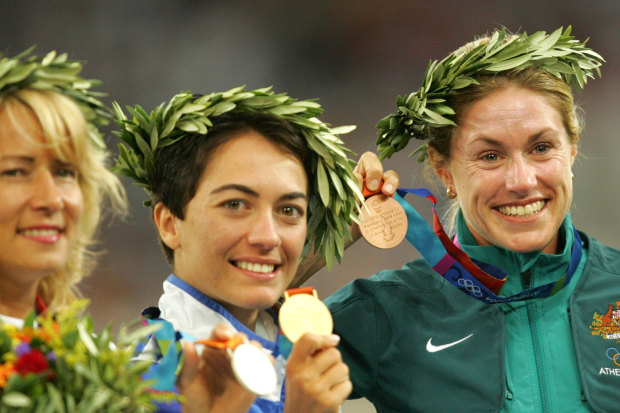
Jane Saville beams after winning Olympic bronze in Athens, 2004.Credit: Fairfax Media
"We chatted away and my friend said: 'You don't know who this is do you? He is the guy who disqualified you in Sydney'," Saville said.
"We laughed and had a nice time. I knew he was just the messenger that day so obviously I held no ill-will. We actually got a photo with me and Lamberto and his red paddle."
She hadn't seen that device of doom in eight years. It was the same paddle Vacchi used in Sydney.
Saville revealed she had tried to buy her infamous red paddle in the post-Olympics equipment sell-off in 2000, but organisers came up empty-handed.
"I thought if I didn't get the gold medal, I want that red paddle," Saville said.
"But I came to realise it was Lamberto's personal one – they take them with them around the world. We ended up getting a photo. It's on a disc in my garage in Sydney, somewhere. It was a fun night."
Saville now splits time between homes in Australia and in Oliva, outside Valencia, with her kids and husband Matt White, a former pro cyclist who is now sporting director of the Mitchelton-Scott professional team.
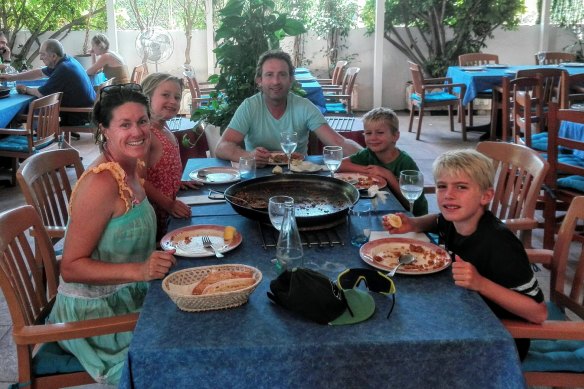
Jane Saville, with her family in Spain. From left: Jane, Zoe, Matt White, Kobi, Jordi.
Saville joined the IAAF's racewalking committee after retirement for a few years and worked – ever so briefly – as a judge herself.
"I followed Saville's career as an IAAF manager. We met a few times and it was very polite," Vacchi said.
"I always admired her gracious response to what happened."
Saville remains gracious.
"I crossed paths with him a number of times, it's such a difficult job being a judge, so hat's off to them," Saville said.
"We did talk about it [Sydney]. He said it was really difficult ... it couldn't have not affected you. Especially the way everyone misinterpreted the whole thing, thinking he was the villain and he killed my Olympic dream. We are a passionate bunch in Australia, so it was a lot of pressure on him, the poor guy."
Vacchi is now 80, happily retired from the bank and living in the Tuscan hills. He has two children, Claudia and Sebastiano, and four grandchildren, who he proudly rates as "all great sportsmen".
"I live in a small village of 550 inhabitants in the mountains between Florence and Bologna, I organise trail running events and I manage a library," Vacchi said.
"Having reached the age of 80 and left the judging world, I hope to be remembered for all my teaching – not the disqualifications."
Saville can't believe 20 years have marched by. She is currently occupied by the progress of her husband's team in the Tour de France, her kids' despair about Lionel Messi leaving Barcelona and a worry for Olympic athletes impacted by COVID-19.
But she doesn't sweat the events of Sydney. Saville admits she sometimes daydreams about walking back into the sunshine and onto the red track, and hearing the mighty roar and winning gold.
But given where life has taken her since Lamberto's paddle changed all that, she reckons wouldn't change a thing.
"I would have just been one of many [Australian] gold medallists in Sydney, how many were there? 17? 18?," Saville says.
"But I am different. My story is different. I won a medal in Athens, which I am extremely proud of. And that's what makes the Olympics, it's all about people's stories.
"It's great you spoke to Lamberto because people forget, the Olympics is the pinnacle for an official too. Their stories matter just as much.
"Sydney, when I think back now, it was a beautiful experience.
"I remember my Dad told me he was going home on the bus and all the people were talking about racewalking. Like, no one ever talks about racewalking.
"And a friend also told me they'd been at the pub and after my race, a big group of blokes were there and they were all arguing about racewalking.
"That's pretty cool. I like that."